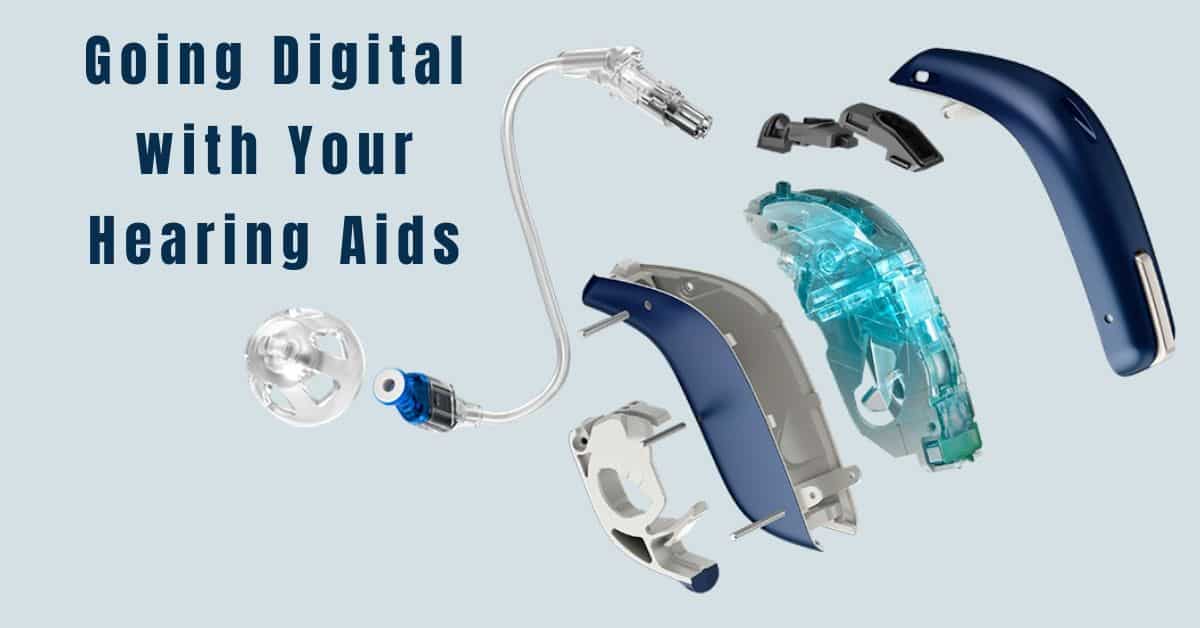
With the past decade comes a digital revolution in hearing aids. This new generation of hearing aids brings with it astounding power and nuance, alongside sleek and discrete design. What exactly is digital hearing technology, what are it’s features and what can we expect for the future of hearing aids?
Analog Vs. Digital
While Analog and Digital hearing aids both can amplify sound, digital takes things a step further to eliminate frequencies and noise patterns and even shift sounds to more comfortable ranges. Whether a hearing aid is digital or analog, it has the same basic structure, although it will process sound differently. In both cases, a microphone is used to pick up sounds in the surrounding environment. The sound is then amplified and delivered to the ear canal via a receiver.
Analog hearing aids directly amplify the sounds they receive without digital assistance. This means that all incoming sounds undergo amplification, even background noise that makes it harder for the listener to hear. Analog hearing aids do offer some programmable features, that can help a user adapt to sound in distinctly noisy or quiet environments but it functions without the responsiveness and nuance of digital processing.
The Digital Advantage
Digital hearing aids work on the same principles as analog, but add additional processing of incoming sound to make the listening experience better matched to the listener’s hearing needs. A microphone still feeds incoming sound into amplification circuits, which delivers sound to a receiver in the ear. Within the amplification process, digital hearing aids truly outshine analog capabilities.
Digital hearing aids are built around digital signal processing, or DSP for short. DSP converts incoming sound into a digital signal, which is processed by microcomputers within the hearing aid to amplify and deliver sound to the user.
Digital Signals
With all incoming sound converted from sound waves to digital signals, digital hearing aids can deliver precise performance in raising the specific frequencies your hearing loss requires. Sound processing algorithms mean that incoming sound can be continually and fluidly adapted to –beyond basic presets.
Smartphone Compatible
Many hearing aids can now connect to your Smartphone to enhance your overall hearing experience. Here are a few of the features you may be able to use with your hearing aids and Smartphone:
- Stream phone calls directly through your hearing aids
- Stream audio, such as driving directions, directly to your hearing aids
- Switch between the programs or memories set by your provider
- Find lost hearing aids
- Check battery status
- Change left and right volume together or separately
Speech Recognition Software
Beyond just our ability to perceive certain frequencies, speech also requires us to focus our energy on certain sounds. As we age and begin to lose our hearing, these changes are often most noticeable in noisy environments. This is often why those who suffer from hearing loss withdraw from social situations in environments where ambient noise makes understanding conversation more difficult.
Speech recognition software does more than just adjust and amplify certain frequencies – they often also allow us to amplify sounds coming from a certain direction. They do this with the use of directional microphones, which are adjusted either manually or automatically depending on the aid. So instead of amplifying sounds that come from all around us, you can focus on sounds coming from right in front of you. That makes understanding speech much easier. Depending on your aid, you can adjust the microphones’ direction manually or automatically.
Artificial Intelligence
AI has revolutionized the hearing aid industry and has brought a wide array of capabilities to the technology that helps you hear. Hearing aids built with AI can detect your environment and learn what noises you wish to focus on. AI hearing aid features released in 2018 include step trackers, a cognitive tracker, and language translation. Soon, they will be able to detect falls
My Hearing Centers
With so many options for hearing aids, picking the right one will make a big impact on your life. At My Hearing Centers, we will work with you and the results of your hearing exam to ensure the digital processing is handling sound to your best advantage. Now is the moment to take the leap and explore what the future of hearing aids has to offer.
